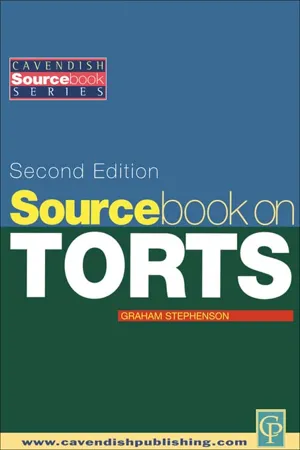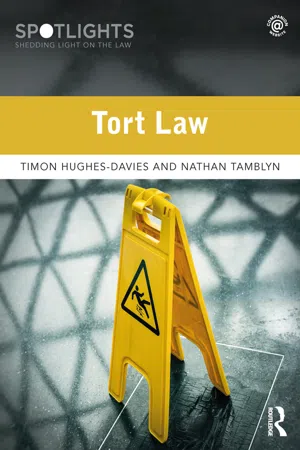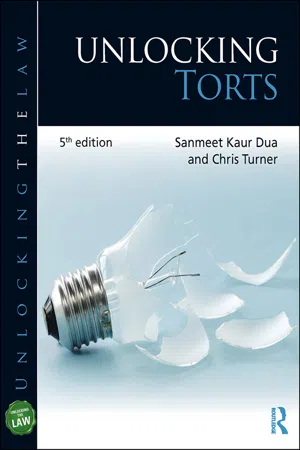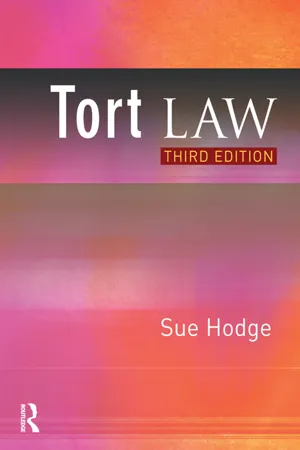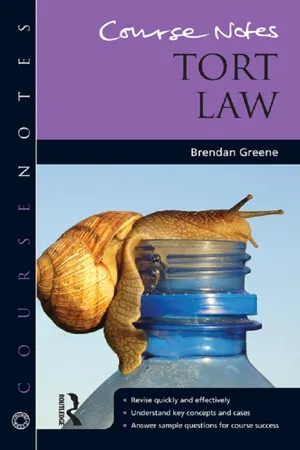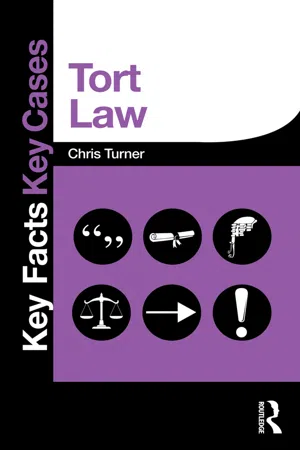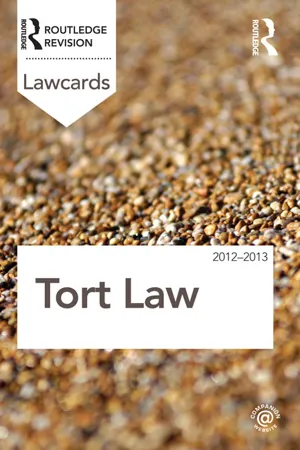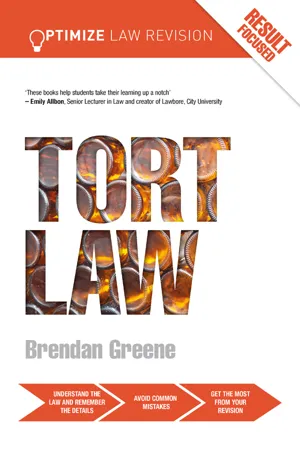Law
Occupiers Liability Act 1984
The Occupiers Liability Act 1984 is a UK law that sets out the duty of care owed by occupiers of premises to visitors. It distinguishes between lawful visitors, such as invited guests, and trespassers, and outlines the responsibilities of occupiers towards each category. The Act aims to ensure that occupiers take reasonable steps to protect the safety of those who enter their premises.
Written by Perlego with AI-assistance
8 Key excerpts on "Occupiers Liability Act 1984"
Learn about this page
Index pages curate the most relevant extracts from our library of academic textbooks. They’ve been created using an in-house natural language model (NLM), each adding context and meaning to key research topics.
- eBook - ePub
- Graham Stephenson, Graham Stephenson(Authors)
- 2012(Publication Date)
- Routledge-Cavendish(Publisher)
This approach avoided, at least for a short period, the need for the courts to reach out for the implied licence cases to bring the child trespasser within the fold of the lawful visitor. The approach was not considered satisfactory and the matter was referred to the Law Commission 19 whose report provided the basis for the 1984 Act. The Occupiers’ Liability Act 1984 Section 1 (1 The rules enacted by this section shall have effect, in place of the rules of the common law, to determine: (a) whether any duty is owed by a personal occupier of premises to persons other than his visitors in respect of any risk of their suffering injury on the premises by reason of any danger due to the state of the premises or to things done or omitted to be done on them; and (b) if so, what that duty is. (2) For the purpose of this section, the persons who are to be treated respectively as an occupier of any premises (which for these purposes, include any fixed or movable structure) and as his visitors are: (a) any person who owes in relation to the premises the duty referred to in s 2 of the Occupiers’ Liability Act 1957 (the common duty of care); and (b) those who are his visitors for the purposes of that duty. (3) An occupier of premises owes a duty to another (not being his visitor) in respect of any such risk as is referred to in sub-s (1) above if: (a) he is aware of the danger or has reasonable grounds to believe it exists; (b) he knows or has reasonable grounds to believe that the other is in the vicinity of the danger concerned or that he may come into the vicinity of the danger (in either case, whether the other has lawful authority for being in that vicinity or not); and (c) the risk is one against which, in all the circumstances of the case, he may reasonably be expected - eBook - ePub
- Timon Hughes-Davies, Nathan Tamblyn(Authors)
- 2019(Publication Date)
- Routledge(Publisher)
Chapter 11Occupiers’ Liability
This chapter discusses the duty of occupiers to take reasonable care of visitors under the Occupiers’ Liability Act 1957, and of non-visitors under the Occupiers’ Liability Act 1984.If someone trips over a loose tile on the floor of a hotel lobby, can they sue for their injury? What if that person was trespassing? This chapter is about the duty of care owed by occupiers of ‘premises’ (typically land or buildings) to other people on those premises. The duty of care owed to visitors is governed by the Occupiers’ Liability Act 1957. The duty of care owed to non-visitors (usually trespassers) is governed by the Occupiers’ Liability Act 1984.This chapter proceeds as follows. First, we shall consider some themes and concepts common to both Acts. Second, we shall discuss the duty of care owed to visitors. Third, we discuss the duty of care owed to non-visitors. Finally, we shall explore some common defences.____________As you read
- Identify the differences between the regimes of the 1957 Act and the 1984 Act.
- Identify the common ground shared by the two Acts.
- Be aware of how the facts might give rise to other causes of action in tort besides occupiers’ liability.
- Consider whether the law strikes a fair balance between the duties imposed on an occupier and the person injured on their premises.
11.1 Common themes
In this section, we explore how occupiers’ liability is concerned with the condition of the premises, rather than activities performed on those premises. Then we turn to consider concepts (like ‘occupier’ and ‘premises’) common to both the 1957 Act and the 1984 Act.Liability for condition of premises
Although there remains some academic discussion of the point, the case law seems to suggest that occupiers’ liability is concerned only with the condition of the premises, that is, whether the premises themselves are safe or not. It is not concerned with the occupier’s activities on the premises.1 - eBook - ePub
- Sanmeet Kaur Dua, Chris Turner(Authors)
- 2019(Publication Date)
- Routledge(Publisher)
‘The Occupiers’ Liability Act 1957 modifies the common law to the extent that the safety of lawful visitors is ensured.’ Discuss how the law on occupiers’ liability has developed in the light of the above statement.SUMMARY
■ Occupiers’ liability is covered by two Acts: the Occupiers’ Liability Act 1957 for lawful ‘visitors’, and the Occupiers’ Liability Act 1984 for trespassers.■ An ‘occupier’ is anybody in actual control of the land and premises is broadly defined.■ By s2(1) of the 1957 Act a ‘common duty of care’ is owed to all lawful visitors.■ By s2(2) the duty is to ensure that the visitor is safe for the purposes of the visit.■ Under s2(3) an occupier must take extra care for children, who are less cautious, and not allure them – although parents are responsible for young children.■ A person carrying out a trade or calling on the occupier’s premises must guard against the risks associated with the trade.■ The occupier is not liable for damage which is the result of work done by independent contractors if:■ it is reasonable to entrust the work■ a reputable contractor is chosen, and■ the occupier inspects the work if necessary.■ Adequate warnings; exclusion clauses and the defences of consent or contributory negligence can also be used to avoid liability.■ Trespassers are protected by the 1984 Act under s1(3) if the occupier:■ is aware of the danger■ knows of the trespass, and■ the risk is one against which he may be expected to offer some protection but only covers personal injury.Further reading
Farrelly, M, ‘Dangerous premises and liability to trespassers’ (2001) 151 NLJ 309.Harvey, B and Marston, J, Cases and Commentary on Tort (4th edn, Longman, 2000), Chapter 7.Wilkinson, H, ‘Boys will be boys’ (2000) 150 NLJ - 4 Negligence and dangerous premises The Occupiers’ Liability Acts 1957 and 1984Although the problems posed by dangerous premises are addressed in this chapter, it is important to bear in mind that many of the matters already discussed will be relevant to this. We will come back to this point later.The essence of the problem connected with dangerous premises is to identify those persons to whom a duty of care is owed, the person who owes that duty and the extent of the duty. This chapter starts by considering the distinction between lawful and unlawful visitors and discussing the identity of the person who owes the duty. It will go on to discuss the nature of the duty owed to particular categories of visitors.Lawful and unlawful visitorsUntil recently the occupier of land and premises could escape liability for negligent injury caused to someone on that land or in those premises by establishing that the person had no right to be there. This is an example of the maxim discussed under the heading ‘Participation in an unlawful act (ex turpi causa non oritur actio)’ in Chapter 5 (see pp. 106 –107 ). A person classified as a trespasser was historically given no protection.Problems could arise in respect of lawful visitors as the duty of care owed by an occupier varied according to the nature of the permission which allowed the person to enter the land. Parliament acted, following the recommendations of the Third Report of the Law Reform Committee (Cmd 9305) 1954, which dealt with some of these problems, and then passed the Occupiers’ Liability Act 1957.The Act ensures that any visitor with either express or implied permission or lawful authority to be on the land has the benefit of the protection of the Act. It is not difficult to identify such categories of visitors. Persons who have received a specific invitation are obviously included as are those who have paid for the right of entry, for example to a theme park or to a cinema. Others included are those who visit premises as a result of implied permission, for example a person delivering milk which has been ordered or a person delivering the post, or the fire brigade summoned to deal with a fire emergency. Lawful authority will extend to the police and other persons exercising rights granted by a warrant.
- eBook - ePub
- Brendan Greene(Author)
- 2013(Publication Date)
- Routledge(Publisher)
hapter 10Occupiers’ Liability 10.1 Introduction- The tort of occupiers’ liability deals with the liability of the occupier of premises to those who come on to the premises. The rules were originally developed by the common law but the above two statutes were passed to clarify the law and they set out more detailed rules.
- At common law entrants to land were divided into four categories and the duty owed to them became progressively less.
Contractual visitor duty to see premises were safe e.g. paying customer at a swimming pool Invitee duty to prevent damage from an unusual danger e.g. customer in a shop Licensee duty to protect from concealed danger e.g. asking a friend to visit your house Trespasser duty not to intentionally or recklessly harm e.g. someone climbs into your garden over your garden wall - The above rules were set out in Addie & Sons v Dumbreck [1929]. In British Railway Board v Herrington [1972] the House of Lords said that trespassers were owed a ‘duty of common humanity’ which was a minimum level.
- The common law rules are still relevant as s1 Occupiers’ Liability Act (OLA) 1957 says that visitors are those who were invitees or licensees.
- Also if an entrant falls outside the requirements of either of the two OLAs then the common law rules apply.
- OLA 1957 covers:
- personal injury
- death
- damage to property.
- OLA 1957 s1(3)(a) provides that the Act covers ‘the obligations of a person occupying or having control over any fixed or movable structure including any vessel, vehicle or aircraft’. This has even been held to apply to a ladder, Wheeler v Copas [1981].
- The OLA 1957 does not define occupier but says that the common law rules apply.
- Wheat v Lacon
- 4 Occupier’s liability4.1 Liability to lawful visitors under the 1957 Act4.1.1 Introduction1 Occupier’s Liability Act 1957 – covers liability to visitors.2 1984 Act covers liability to non-visitors (mainly trespassers).3 Both Acts only cover damage resulting from state of premises – other damage is covered by negligence (Ogwo v Taylor (1987)).4.1.2 Definition of occupier (potential defendants)1 There is no real statutory definition so common law test applies: who has control of premises? (Wheat v Lacon (1966)).2 Dual occupation possible – identity of the defendant depends on the nature of the interest, etc. (Collier v Anglian Water Authority (1983)).3 In an action a lawyer’s main concern is who has means to be sued.4 There is no need for proprietary interest or possession, only control, so different from trespass (Harris v Birkenhead Corporation (1976)).4.1.3 Definition of premises1 No complete definition in either Act, so common law applies.2 It obviously includes houses, buildings, land, etc. but also:ships in dry dock (London Graving Dock v Horton (1951));vehicles (Hartwell v Grayson (1947));lifts (Haseldine v Daw & Son Ltd (1941));aircraft (Fosbroke-Hobbes v Airwork Ltd (1937));and even a ladder (Wheeler v Copas (1981)).3 The 1957 Act in s 1(3)(a) preserves the common law (‘fixed or movable structure, including any vessel, vehicle or aircraft…’).4.1.4 Potential claimants1 The 1957 Act simplified complex common law classes of entrant. These were:invitee – enters in material interest of occupier, e.g. a shop customer, a friend visiting;licensee – mere permission, e.g. a person taking a short cut;a person entering under a contract, e.g. a painter (duty depended on contract) – a subcontractor is only a licensee;
- eBook - ePub
- Routledge(Author)
- 2013(Publication Date)
- Routledge(Publisher)
Occupiers’ liabilityWhat is the scope of the 1957 and 1984 Occupiers’ Liability Acts? Who is an occupier? Who is a visitor? What is the standard of care? What are the rules for independent contractors? Can liability be excluded? Does the occupier owe a duty of care to trespassers? How is the duty discharged? LIABILITY UNDER THE OCCUPIERS’ LIABILITY ACT 1957
The law of occupiers’ liability exists to ensure that an occupiers’ land is not dangerous to others. It is governed by statute law which was introduced to clarify the pre-existing common law. The original Occupiers’ Liability Act 1957 which protected lawful visitors to land was joined by the Occupiers’ Liability Act 1984 which extended liability to injury suffered by trespassers.WHO IS AN ‘OCCUPIER’ FOR THE PURPOSES OF THE ACT?
Common law rules apply
The 1957 Act does not define what constitutes an occupier but stipulates that the rules of the common law shall apply (s 1(2)).The test is one of control and not exclusive occupation
WHEAT v E LACON & CO LTD [1966]
Basic facts
The defendants owned a public house and the manager and his wife occupied the upper floor. The managers’ wife was allowed to take paying guests, and one of these guests had an accident on the staircase leading to the upper floor. It was held that the defendants were occupiers of the upper floor as they exercised residuary control.Relevance
The basic test for an occupier is one of control over the premises. There can be more than one occupier of premises at any given time.It is not necessary to be present on the premises
In Harris v Birkenhead Corporation [1976] - eBook - ePub
- Brendan Greene(Author)
- 2017(Publication Date)
- Routledge(Publisher)
1984 , were passed to clarify the law and to set out detailed rules. These rules are in effect statutory negligence.At common law the entrants to land were divided into four categories which were created inAddie & Sons v Dumbreck [1929]AC 358 as set out in the table below. The duty owed became progressively less until it came to trespassers when the duty was merely not to harm them. Although the categories are still relevant the duties owed have been changed by the Occupiers’ Liability Acts .Contractual visitor Occupier has a material interest in their visit. Duty to see that the premises are safe, e.g. a paying customer at a swimming pool Invitee Duty to prevent damage from an unusual danger, e.g. a customer in a shop is owed this duty Licensee Duty to protect from any concealed danger the occupier knows of, e.g. asking a friend to your house Trespasser Duty not to intentionally or recklessly harm, e.g. someone climbs over your garden wall The common law rules are still relevant as s1 Occupiers’ Liability Act 1957 (OLA 1957 ) provides that visitors are those who were invitees or licensees at common law. The OLA 1957 also includes contractual visitors under s5(1). All these three categories are now ‘visitors’ and owed the common duty of care under s2(1) OLA 1957 . Trespassers are now covered by the OLA 1984 .If an entrant to land falls outside the rules of both Occupiers’ Liability Acts then the common law rules apply to them. InBritish Railways Board v Herrington
